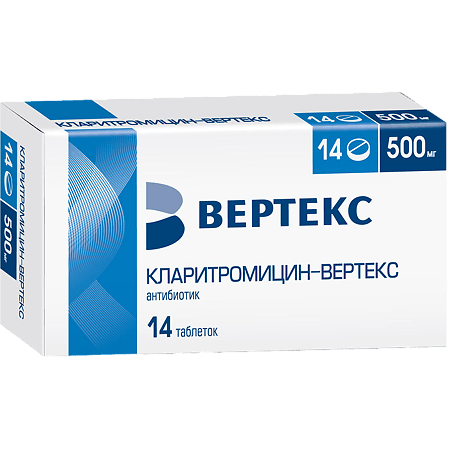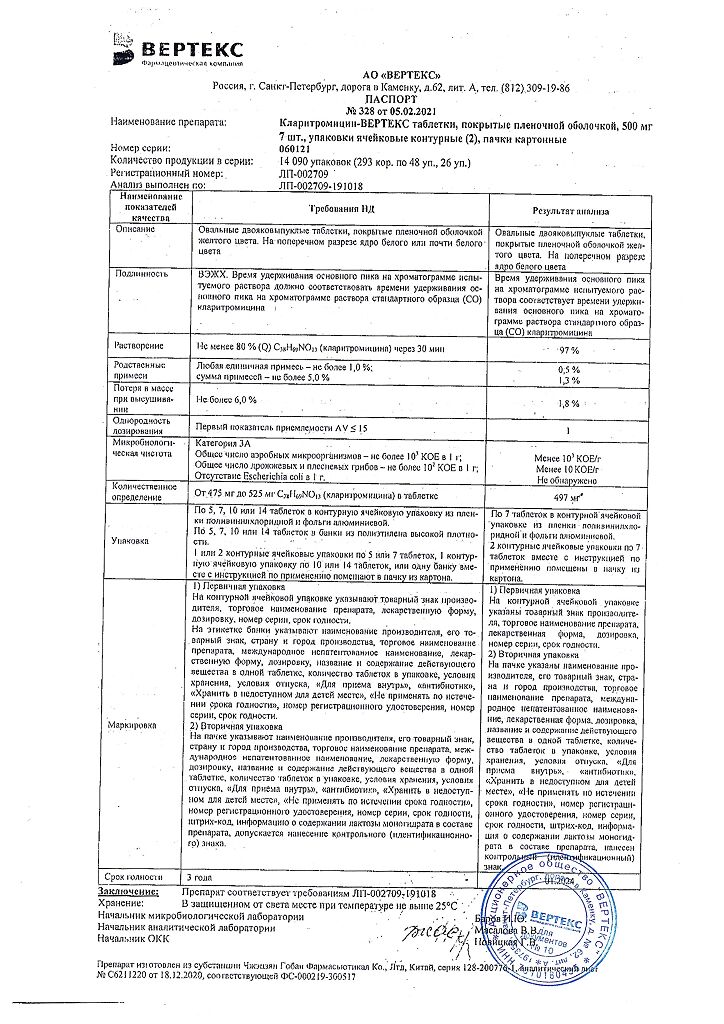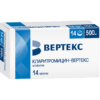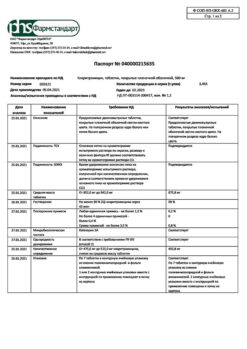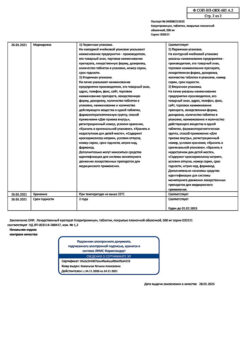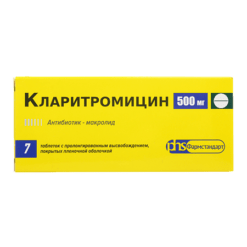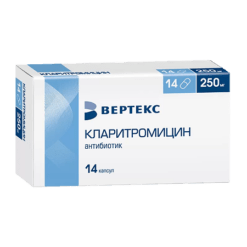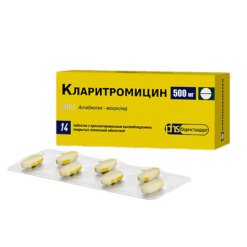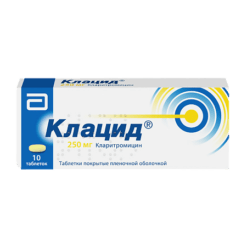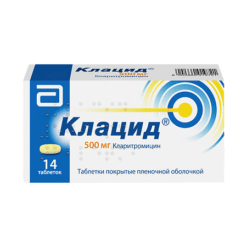No products in the cart.
Clarithromycin, 500 mg 14 pcs
€13.53 €11.27
Out of stock
(E-mail when Stock is available)
Description
Clarithromycin is a semi-synthetic broad-spectrum macrolide antibiotic. Antibacterial effect of clarithromycin is achieved by inhibition of protein synthesis due to binding to 50s-subunit of bacterial ribosomes. Clarithromycin has pronounced activity against a wide range of aerobic and anaerobic gram-positive and gram-negative organisms. Minimum inhibitory concentration of clarithromycin (MIC) is half that of erythromycin for most microorganisms.
The 14-hydroxy metabolite of clarithromycin also has antimicrobial activity. Minimum inhibitory concentrations of this metabolite are equal to or greater than the MAC of clarithromycin; against H.influenzae the 14-hydroxy metabolite is twice as active as clarithromycin.
Clarithromycin exhibits in vitro activity against the following organisms:
Grampositive aerobic bacteria: Staphylococcus aureus (sensitive to methicillin); Streptococcus agalactiae, Streptococcus pyogenes, Streptococcus pneumoniae, Streptococcus viridans and Listeria monocytogenes
Gram negative aerobic bacteria: Haemophilus influenzae; Haemophilus parainfluenzae; Moraxella (Branhamella) catarrhal is; Neisseria gonorrhoeae; Legionella pneumophila; Bordetella pertussis; Helicobacter pylori; Campylobacter jejuni.
Predominantly intracellular microorganisms: Mycoplasma pneumoniae; Ureaplasma urealyticum Chlamydia trachomatis, Chlamydia pneumoniae; Mycobacterium avium; Mycobacterium leprae, M. kansaii, M. chelonae, M. marinum, M.fortitum.
Anaerobic microorganisms: Bacteroides fragilis; Clostridium perfringens; Propionibacterium acnes, Peptococcus species; Peptostreptococcus species
In addition, the drug is active against Toxoplasma species.
Bactericidal activity of clarithromycin is against some bacterial strains: Haemophilus influenzae; Streptococcus pneumoniae; Streptococcus pyogenes; Streptococcus agalactiae; Moraxella (Branhamella) catarrhalis; Neisseria gonorrhoeae; H. pylori and Campylobacter spp.
Indications
Indications
Infections caused by clarithromycin-sensitive microorganisms.
Active ingredient
Active ingredient
Composition
Composition
1 tablet contains:
Active ingredient:
clarithromycin;
Associates:
MCC,
Potato starch,
Pregelatinized starch,
Low molecular weight PVP,
colloidal silicon dioxide,
magnesium stearate,
sodium lauryl sulfate.
Read more:http://medside.ru/klaritromitsin
How to take, the dosage
How to take, the dosage
Intravenously.
Adults: the usual dosage is 250 mg 2 times a day for 7 days, if necessary, the dose can be increased to 500 mg 2 times a day for a period of up to 14 days for severe infections.
Children over 12 years of age: dosing regimen as for adults.
For treatment of duodenal ulcer caused by H.pylori (adults):
Triple therapy regimen (7-14 days): Clarithromycin 500 mg 2 times daily; lansoprazole 30 mg 2 times daily; amoxicillin 1000 mg 2 times daily;
Triple therapy regimen (7 days): Clarithromycin 500 mg 2 times daily; lansoprazole 30 mg 2 times daily; metronidazole 400 mg 2 times daily.
Triple therapy regimen (7 days): Clarithromycin 500 mg 2 times daily; omeprazole 40 mg daily; amoxicillin 1000 mg 2 times daily or metronidazole 400 mg 2 times daily;
The triple therapy regimen (10 days): Clarithromycin 500 mg 2 times daily is given with amoxicillin 100 mg 2 times daily and omeprazole 20 mg daily;
The dual therapy regimen (14 days): Clarithromycin 500 mg 3 times daily, oral omeprazole 40 mg once daily.
In cases of impaired renal function:
No dose adjustment is usually required except in patients with severe renal impairment (creatinine clearance < 30 ml/min), but if necessary, the total daily dose should be reduced by half, i.e. 250 mg once daily or 250 mg 2 times daily in more severe infections.
In concomitant administration of ritonavir for patients with impaired renal function, a dose adjustment is recommended as follows:
For patients with a creatinine clearance of 30-60 mL/min, the clarithromycin dose should be reduced by 50%. For patients with creatinine clearance less than 30 ml/min, the clarithromycin dose should be reduced by 75%. If clarithromycin and ritonavir are used together, doses of clarithromycin greater than 1 g per day should not be used.
Interaction
Interaction
Clarithromycin inhibits the activity of CYP3A4 isoenzyme, which leads to slower metabolic rate of astemizole when using them simultaneously. As a consequence, the QT interval is prolonged and the risk of ventricular arrhythmia of “pirouette” type increases.
Concomitant use with atorvastatin leads to a moderate increase in plasma concentrations of atorvastatin and an increased risk of myopathy.
Concomitant use with warfarin may increase the anticoagulant effect of warfarin and increase the risk of bleeding.
Concomitant use with digoxin may significantly increase the plasma concentration of digoxin and the risk of glycoside intoxication.
It is believed that there may be an increase in plasma concentration of disopyramide due to inhibition of its metabolism in the liver by clarithromycin. There is a risk of prolongation of QT interval, pirouette-type heart rhythm disturbances, increased insulin secretion and hypokalemia.
Concomitant use with zidovudine slightly decreases bioavailability of zidovudine; with itraconazole – concentration of itraconazole in plasma is significantly increased, it is believed that there is a risk of increased side effect.
Concomitant use with carbamazepine increases plasma concentrations of carbamazepine, there is a risk of increased side effects; with colchicine – there have been described cases of severe, life-threatening toxic reactions due to the action of colchicine; with lansoprazole – glossitis, stomatitis and/or dark coloration of the tongue may occur; with methylprednisolone – clearance of methylprednisolone decreases; with midazolam – concentration of midazolam in blood plasma increases and its effects are enhanced.
Concomitant use with omeprazole significantly increases concentrations of omeprazole and slightly increases plasma concentrations of clarithromycin.
Concomitant use with pimozide increases the plasma concentration of pimozide and there is a risk of severe cardiotoxic effects; with prednisone there have been described cases of acute mania and psychosis; with ritonavir – there may be a significant increase in concentrations of clarithromycin, while the concentration of its metabolite 14-hydroxyclarithromycin decreases significantly; with rifabutin – the concentration of rifabutin in blood plasma increases, the risk of uveitis increases, the concentration of clarithromycin in blood plasma decreases.
Concomitant use with rifampicin significantly decreases plasma concentrations of clarithromycin; with sertraline – theoretically we cannot rule out the development of serotonin syndrome; with theophylline – possible increase in plasma concentrations of theophylline.
In concomitant use with terfenadine, slowing of terfenadine metabolism rate and increasing of its plasma concentration is possible, which may lead to prolongation of QT interval and increased risk of ventricular pirouette arrhythmia.
It is believed that concomitant use with tolbutamide may result in hypoglycemia.
Concomitant use with phenytoin may increase plasma phenytoin concentrations, risk of developing toxic effects.
In concomitant use with fluoxetine, a case of development of toxic effects due to the action of fluoxetine has been described.
Inhibition of CYP3A4 isoenzyme activity by clarithromycin leads to slower metabolic rate of cisapride when using them concomitantly. Consequently, plasma concentration of cisapride increases and the risk of life-threatening cardiac arrhythmias, including pirouette-type ventricular arrhythmias, increases.
Concomitant use with cyclosporine increases the plasma concentration of cyclosporine, there is a risk of increased side effects.
In concomitant use with ergotamine, dihydroergotamine, cases of increased side effects of ergotamine and dihydroergotamine have been described.
Special Instructions
Special Instructions
There is cross-resistance between antibiotics from the macrolide group.
Treatment with antibiotics alters the normal gut flora, so superinfections caused by resistant microorganisms may develop.
We should note that severe persistent diarrhea may be due to development of pseudomembranous colitis.
When used concomitantly with clarithromycin, it is recommended to monitor plasma concentrations of theophylline, carbamazepine, digoxin, lovastatin, simvastatin, triazolam, midazolam, phenytoin, cyclosporine, and ergot alkaloids.
Protrombin time should be periodically monitored in patients receiving clarithromycin concomitantly with warfarin or other oral anticoagulants.
Pediatric use
There are currently insufficient data on the efficacy and safety of clarithromycin in children under 6 months of age.
Contraindications
Contraindications
Side effects
Side effects
nervous system: dizziness, fear, headache, bad dreams, insomnia, feeling of anxiety; in rare cases – hallucinations, disorders of consciousness, psychosis;
digestion: vomiting,nausea,stomatitis,gastralgia, cholestatic jaundice,glossitis,diarrhea, increased liver transaminase activity, in rare cases pseudomembranous enterocolitis appears;
Hematopoiesis, hemostatic system: in rare cases – thrombocytopenia;
senses: feeling of tinnitus, taste disturbance, there have been isolated cases of hearing loss after the drug was withdrawn;
allergies:Itchy skin rash, anaphylactoid reactions, Stevens-Johnson syndrome;
other actions: manifestation of microbial resistance.
Similarities
Similarities
Additional information
| Weight | 0.028 kg |
|---|---|
| Manufacturer | Vertex, Russia |
| Medication form | pills |
| Brand | Vertex |
Other forms…
Related products
Buy Clarithromycin, 500 mg 14 pcs with delivery to USA, UK, Europe and over 120 other countries.

